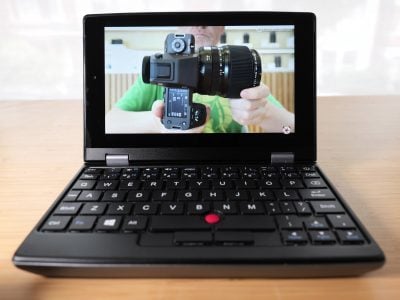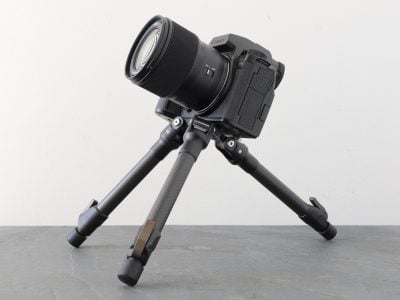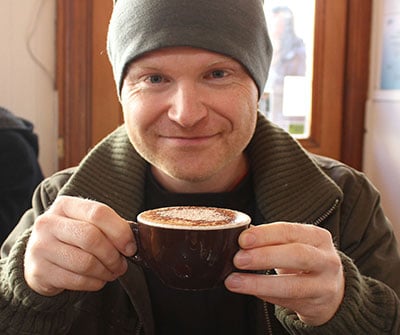Fujifilm instax mini 41 review
-
-
Written by Gordon Laing
The instax mini 41 is Fujifilm’s latest camera to use their hugely popular instax mini film. Launched in April 2025, the mini 41 produces credit-card sized prints using a fully analogue process that eject straightaway and gradually develop before your eyes in roughly 90 seconds. The camera costs around $99 or pounds, while instax mini film costs around $20 or £15 for a twin pack of 20 shots, which works out around a dollar or 75 pence per print.
Fujifilm sells two types of instax cameras: hybrid models like the Mini EVO which have digital sensors, screens to review the images, storage to save them and a built-in printer to make a physical print if you want one. Meanwhile the new mini 41 falls into the second camp: a fully analogue camera with no sensor, screen or storage. Open the body to load a film cartridge and you’ll see the back of the lens which directly exposes the film, before it pops out the top.
It’s a simpler process which is not only cheaper for the body, but one that some prefer as you can’t always predict how the prints will come out and each is unique. They’re not stored digitally, so the only copy you have is the one in your hands. If you want to share it with your phone, you’ll need to take a photo of the actual print. My full review is in the video below, but if you prefer to read the written highlights, keep scrolling!
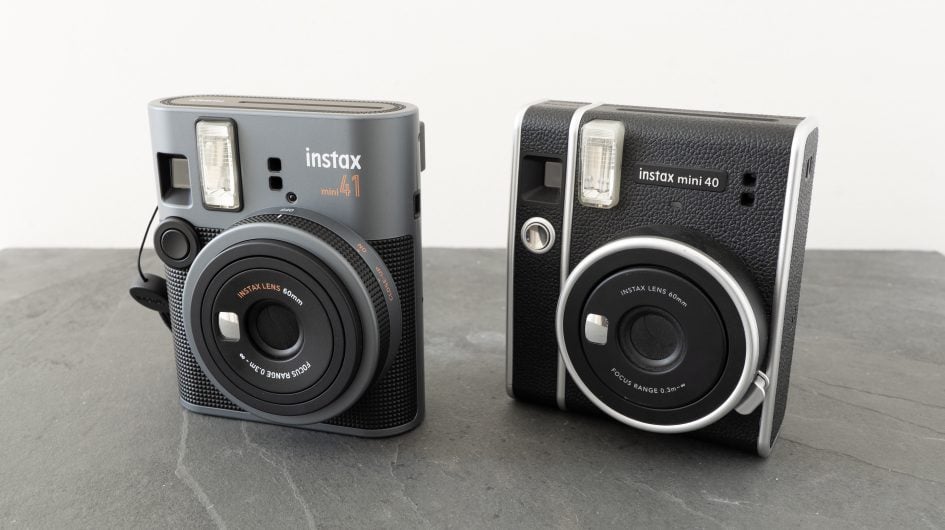
Above: The mini 41 on the left is the follow-up to the mini 40 on the right. Both were designed for those who want the low price and simplicity of a fully analogue instant camera, but with a more serious look then the traditional instax minis. Note the new curvier body when viewed from above, the different grip texture and the two tone colour scheme. It’s all down to personal preferences of course, but I really like the new styling.
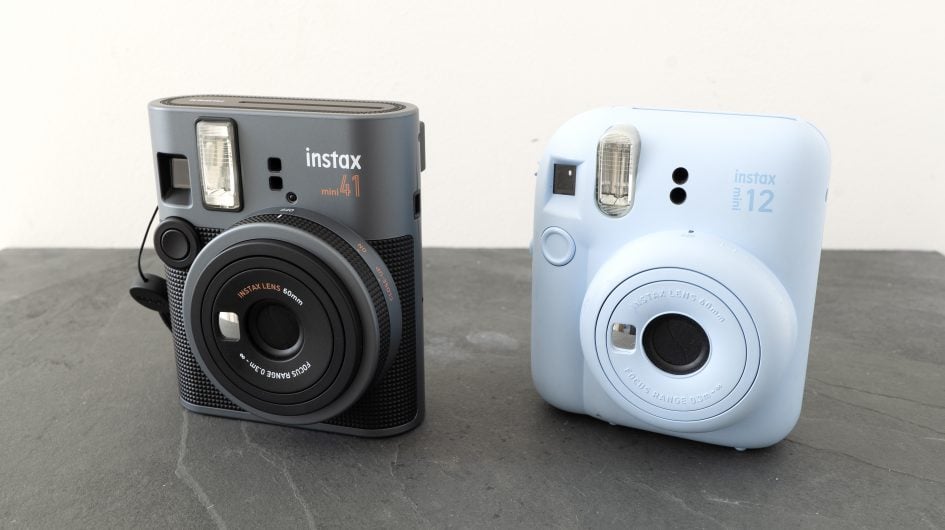
Above: Now let’s keep the mini 41 on the left and pop the more frivolous-looking mini 12 on the right, where the difference in body aesthetic is clear. Which do you prefer? But look a little closer at the details and you’ll notice the viewfinder window, flash, metering sensors and lens details are all in the same places, confirming that the mini 41 is essentially a reskinned mini 12 with the same features and quality. You’re basically just choosing which exterior you prefer, although the mini 12 will also come in a little cheaper if you’re looking for the cheapest possible model.
Like previous models in the entry-level series, the mini 41 is powered by a pair of AA batteries housed in a compartment on the grip side and good for up to 100 shots, or roughly 10 packs of film. Fujifilm includes a pair of disposable Alkalines to get you started.
Round the back you’ll find a large door for loading the film cartridges, although do check the window first for a yellow mark which means you’ve already got one loaded; if you do, a counter towards the bottom right will tell you how many shots you have left. If the counter says S, you’re safe to open the door and load a new cartridge – just align the yellow mark with the one on the camera, push it inside, then close the door.
Next switch on the camera by twisting the lens barrel, then push the shutter button: this ejects the initial safety sheet which you can dispose of, then you’re ready to go. After loading a new cartridge you’ll notice the counter on the rear indicating you have the full ten shots remaining.
The major difference between the 41 and the 40 before it is how you actually switch it on: the Mini 41 employs the same twisting barrel as the mini 12, so one twist will power it up and extend the lens for general use, while a second twist will extend it further for close-ups or selfies.
Compare it to the previous Mini 40 where you’d push a large button to extend the lens and power up the camera, before then manually yanking out the lens further for selfies or close-ups. The twisting control comes from the earlier SQ1, and makes the Mini 41 easier to use than previous models.
To frame your shot, you can either use the simple optical viewfinder when you’re behind the camera, or a small mirror to the left of the lens when you’re shooting selfies. At first glance this would appear no different to the Mini 40 before it, but in a useful upgrade, the mini 41 inherits the parallax correction of the mini 12 where the viewfinder adjusts when you set it to close-up mode. This allows you to more accurately frame subjects at close range and avoid them appearing off-centre.
It’s not perfect, and in some cases your printed subject may still be a bit off-centre, but it’s certainly an improvement and means fewer wasted prints. Switching the camera into selfie / close-up mode also reduces the power of the flash to minimise over-exposed subjects.
As for the lens, it’s the same as before: 60mm which on the Mini format delivers coverage equivalent to around 34mm, capturing a mild wide angle, that’s ideal for general use from portraits and selfies to buildings and landscapes. Again as before, the camera can focus between about half a meter to infinity, but twist the lens into selfie / close-up mode and the range adjusts to between 30 and 50cm.
As for exposure, the mini 41 remains fully automatic, like the 12 before it. Both employ a fixed aperture and automatic shutter speeds between 1/250 and half a second. As before this is adequate for general situations, but will struggle under very dim or bright conditions. The flash fires on every single shot to provide a fill for nearby subjects and is fine for illuminating people or other close objects in dark surroundings, but don’t expect to see much in the background of a dimly-lit club or a dusky landscape.
And at the other end of the scale, the mini 41 still over-exposes bright outdoor scenes. I took it out around Brighton in the UK in Spring towards sunset and many of the outdoor subjects were a little over-exposed – and remember this is in the UK, so beware of using any of the analogue instax cameras for bright daytime photography. It’s frustrating Fujifilm still hasn’t fully addressed this limitation, as having only a slightly faster shutter speed could resolve most over-exposures outdoors. I guess they don’t mind you wasting paper. But so far it affects all basic instax cameras, so at least you’re warned. The photo quality is unsurprisingly similar to the models before it, albeit with the benefit of better-exposed selfies and more accurately framed close-ups. These in turn at least should reduce wasted prints.
Overall the instax mini 41 may be no more than a reskinned mini 12, but that still makes it one of the best budget instax cameras to date, especially if you’re into selfies or portraits. I really like the new body design, more serious and technical looking than the mini 12, but more modern than the mini 40 it replaces. The print quality may be essentially the same as previous models but by reducing the flash power and adjusting the viewfinder when set to close-up mode, the 41 minimises washed-out subjects and inaccurate framing.
I also like the twisting barrel which makes it easier to power-up and enter close-up mode. On the downside though, you will still suffer from over-exposures under bright daylight conditions, but if you mostly photograph people or keep outdoor scenes to dimmer conditions, you’ll be ok.
If you love the instax format, there’s three questions you need to ask yourself: first, what’s your preferred shape, mini, square or wide, as each camera or printer can only use one type.
Second, would you prefer the predictability and easier sharing of a digital hybrid camera like an EVO, or the lower cost and simpler approach of a fully analogue process where each print is unique?
And third, would you be better-served by the ultimate predictability of an instax printer instead? These portable wireless machines will print any photo stored on your phone, including those transferred from a high-end camera.
Instax printers are fully predictable and you only print what you want, making them the more sensible choice for some people, but conversely less fun than the cameras. Also note some of the hybrid cameras can also double-up as wireless printers, giving you the best of both worlds. Only you can decide, but I have reviews of them all here, and if you opt for a budget camera that takes the mini format, then the mini 41 offers a more serious-looking alternative to the mini 12.
Check prices on the instax mini 41 at Amazon, B&H or WEX UK. Alternatively get yourself a copy of my In Camera book, an official Cameralabs T-shirt or mug, or treat me to a coffee! Thanks!
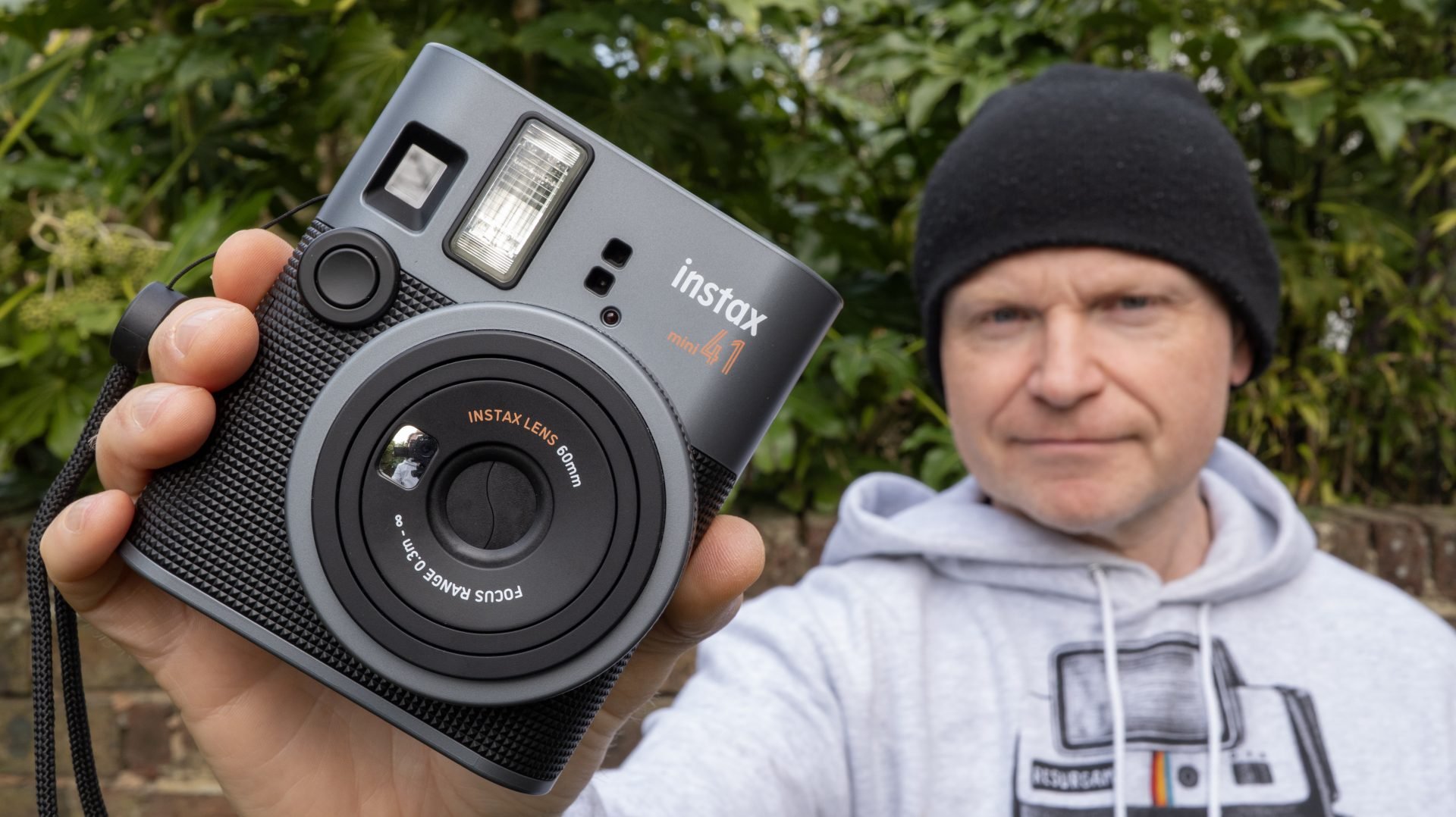
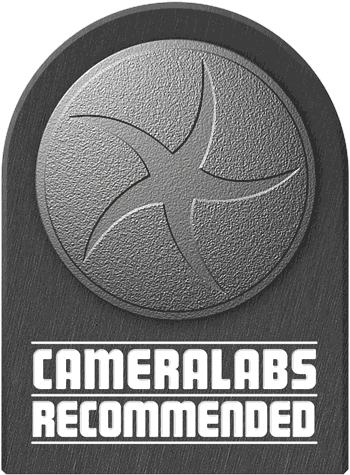 Overall the instax mini 41 may be no more than a reskinned mini 12, but that still makes it one of the best budget instax cameras to date, especially if you’re into selfies or portraits. I really like the new body design, more serious and technical looking than the mini 12, but more modern than the mini 40 it replaces. The print quality may be essentially the same as previous models but by reducing the flash power and adjusting the viewfinder when set to close-up mode, the 41 minimises washed-out subjects and inaccurate framing. I also like the twisting barrel which makes it easier to power-up and enter close-up mode. On the downside though, you will still suffer from over-exposures under bright daylight conditions, but if you mostly photograph people or keep outdoor scenes to dimmer conditions, you’ll be ok.
Overall the instax mini 41 may be no more than a reskinned mini 12, but that still makes it one of the best budget instax cameras to date, especially if you’re into selfies or portraits. I really like the new body design, more serious and technical looking than the mini 12, but more modern than the mini 40 it replaces. The print quality may be essentially the same as previous models but by reducing the flash power and adjusting the viewfinder when set to close-up mode, the 41 minimises washed-out subjects and inaccurate framing. I also like the twisting barrel which makes it easier to power-up and enter close-up mode. On the downside though, you will still suffer from over-exposures under bright daylight conditions, but if you mostly photograph people or keep outdoor scenes to dimmer conditions, you’ll be ok.
